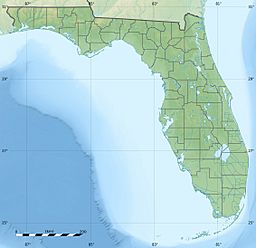Edward Medard Park and Reservoir facts for kids
Quick facts for kids Edward Medard Reservoir |
|
|---|---|
| Location | Plant City, Hillsborough County, Florida |
| Coordinates | 27°55′52″N 82°10′08″W / 27.931°N 82.169°W |
| Type | reservoir |
| Basin countries | United States |
| Managing agency | Hillsborough County Parks and Recreation Department |
| Designation | Fisheries Management Area |
| Built | 1970 |
| Surface area | 770 acres (3.1 km2) |
| Average depth | 6.36 ft (1.94 m) |
| Max. depth | 21.48 ft (6.55 m) |
| Water volume | 1,474,561,838 US gallons (1.228 billion imperial gallons; 5.582 cubic hectometres) |
| Shore length1 | 115,290 ft (35,140 m) |
| Surface elevation | 58.52 ft (17.84 m) |
| 1 Shore length is not a well-defined measure. | |
Edward Medard Park and Preserve is a popular outdoor spot in Hillsborough County, Florida. It was once called Pleasant Grove Reservoir Park. This large park covers about 1,284-acre (5.20 km2) of land. It is located south of Plant City, Florida, near Durant, Florida.
Years ago, in the 1960s, this area was used for phosphate mining. Later, in 1969, the land was given as a gift. In 1970, a large wall called a dike was built. This created a 770-acre (3.1 km2) reservoir, which is like a big lake. Its main purpose was to help prevent floods along the Alafia River. The lake has a very interesting shape with many curves. Its bottom also has many different depths.
The Hillsborough County Parks and Recreation Department takes care of the park. It offers many fun activities. You can go camping, have picnics, and enjoy other outdoor sports. There are three long piers where you can launch boats. However, boats must go slowly on the lake to create no waves. About 250,000 people visit this park every year.
Contents
Edward Medard Park: A Fishing Hotspot
In the early 2000s, experts realized the old dam at the lake needed repairs. It was important to fix it to keep people living downstream safe. So, in 2010, the lake was almost completely emptied. It was closed for fishing for three years. This allowed workers to make the dam stronger and prevent soil from washing away. They also added new features like a boardwalk and a new dock.
When the lake was drained, many fish were removed. These included tilapia and catfish. A state senator named Ronda Storms suggested a great idea. The fish were prepared and given to America's Second Harvest. This organization then shared the fish with local charities. These charities helped feed people who were hungry.
Reopening and Fish Management
The lake reopened in December 2012. It was then named a Fisheries Management Area (FMA). This special title was given by the Florida Fish and Wildlife Conservation Commission (FWC). The FWC set special rules for fishing. These rules limit how many fish you can catch and how big they can be. Commercial fishing for certain types of fish, like tilapia and sailfin catfish, was allowed only on Tuesdays, Wednesdays, and Thursdays.
During the dam's reconstruction, several artificial reefs were placed in the lake. These are special underwater structures that provide homes for fish. The lake was also restocked with many young fish. About 1.2 million small "fingerling" sportsfish were added. This included a quarter-million Florida-strain largemouth bass. Plus, 6,600 larger fish were moved from other lakes in 2012.
Park Features and Activities
Edward Medard Park offers many exciting things to do. You can climb a 40-foot tall observation tower. From the top, you get amazing views of the lake. The park also has 42 campsites where you can stay overnight. If you like disc golf, there's a course for that too.
The park has several trails for you to explore. Some are for hiking, and others are for riding horses. If you don't have your own horse, you can rent one at the nearby Turkey Creek Stables. There are small fees to enter the park, launch a boat, or rent a canoe or kayak. Camping also has an extra charge.
Plants and Nature at the Park
Edward Medard Park is home to many different kinds of plants. You can see plants that float on the water. These include American Lotus, Water Lettuce, and Water Hyacinth. There are also many plants that grow partly in the water and partly above it. Some examples are Wild Taro, Muscadine grape, and cattails. The park's diverse plant life adds to its natural beauty.



